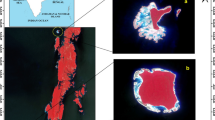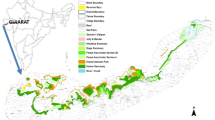Abstract
Saint Martin’s is a unique island located in the Bay of Bengal where coral species are abundant due to its favorable and unique environmental conditions. Coral communities are in great danger due to global climate change, direct commercial coral extraction and unplanned tourism around the island. The present study attempts to identify the coral zone and mapping of coral reefs from the period of 1980 to 2018. The study utilized five sets of multi-temporal Landsat satellite images to examine the changes of coral reefs in Saint Martin’s Island during the study timeframe. Geospatial and image processing software was used for spatial coral colony mapping and data analysis. Satellite images processed to remove water depth impacts and supervised classification technique using the maximum likelihood decision rule suggested the spatial change of coral colonies over time. The result of the study indicates that coral colonies decreased steadily throughout the study period. A total area of 0.9342 km2 of coral colonies disappeared during the study period from 1980 to 2018. Field observations around Saint Martin’s Island indicates that destruction of coral reef habitat was basically caused by anthropogenic activities like tourism and extraction of coral by fisherman. Analysis of the historical data regarding tourism, population and households, and Sea Surface Temperature (SST) along with field observations of these parameter during 2018, suggests that anthropogenic factors are more significant than natural factors for causing coral reef degradation. It is very crucial to raise consciousness not only in the vicinity of Saint Martin’s Island but more widely regarding the significance of the biodiversity of the Island.
Similar content being viewed by others
References
Ahammed SS, Hossain MA, Abedin MZ, Khaleque MA (2016) A study of environmental impacts on the coral resources in the vicinity of the Saint Martin Island. Bangladesh. IJSTR 5(1):37–39
Ahmed M (1995) An overview on the coral reef ecosystem of Bangladesh. Bangladesh J Environ Sci 1:67–73
Alam O, Deng TL, Uddin MN, Alamgir M (2015) Application of environmental ethics for sustainable development and conservation of Saint Martin’s Island in Bangladesh. JESNR 8(1):19–27
Ali MO, Ahmed M (2000) Bio-diversity conservation: Vision of Bangladesh. Bangladesh State of Environment Report, Dhaka Antonius A (1985) Coral disease in the Indo-Pacific: a first recording. PSZNI Mar Ecol 6:197–218
Banglapedia (2008) St Martin’s Island. National Encyclopedia of Bangladesh. http://en.banglapedia.org/index.php?title=St_Martin%27s_Island Accessed 14 Sep 2019
BBS (2011) Population and Housing Census 2011. Bangladesh Bureau of Statistics (BBS), Ministry of Planning, Government of the People’s Republic of Bangladesh, Dhaka. http://www.bbs.gov.bd/site/page/47856ad0-7e1c4aab-bd78-892733bc06eb/Population-and-Housing-Census Accessed 9 Dec 2019
Bierwirth PN, Lee TJ, Burne RV (1993) Shallow sea-floor reflectance and water depth derived by unmixing multispectral imagery. Photogramm Eng Rem S 59(3):331–338
Briguglio L, Briguglio M (1996) Sustainable tourism in small islands: The case of Malta. Cassel/Pinter, London, 93 p
Bruno JF, Selig ER (2007) Regional decline of coral cover in the Indo-Pacific: Timing, extent, and sub regional comparisons. PLoS One 2(8):e711. doi:https://doi.org/10.1371/journal.pone.0000711
Burke L, Reytar K, Spalding M, Perry A (2011) Reefs at Risk Revisited. World Resources Institute, Washington DC, 104 p
Carriquiry JD, Cupul-Magaña AL, Rodríguez-Zaragoza F, Medina-Rosas P (2001) Coral bleaching and mortality in the Mexican Pacific during the 1997–98 El Niño and prediction from a remote sensing approach. B Mar Sci 69(1):237–249
Donner SD, Skirving WJ, Little CM, Oppenheimer M, Hoegh-Guldberg O (2005) Global assessment of coral bleaching and required rates of adaptation under climate change. Glob Change Biol 11:2251–2265. doi:https://doi.org/10.1111/j.1365-2486.2005.01073.x
Dustan P, Dobson E, Nelson G (2001) Landsat Thematic Mapper: detection of shifts in community composition of coral reefs. Conserv Biol 15(4):892–902. doi:https://doi.org/10.1046/j.1523-1739.2001.015004892.x
English SS, Wilkinson CC, Baker VV (1997) Survey manual for tropical marine resources. Australian Institute of Marine Science, Townsville, 390 p
Gattuso JP, Hoegh-Guldberg O, Pörtner HO (2014) Cross-chapter box on coral reefs. In: Field CB, Barros VR, Dokken DJ, Mach KJ, Mastrandrea MD, Bilir TE, Chatterjee M, Ebi KL, Estrada YO, Genova RC, Girma B, Kissel ES, Levy AN, MacCracken S, Mastrandrea PR, White LL (eds) Climate Change 2014: Impacts, Adaptation, and Vulnerability. Part A: Global and Sectoral Aspects. Contribution of Working Group II to the Fifth Assessment Report of the Intergovernmental Panel on Climate Change. Cambridge University Press, Cambridge and New York, pp 97–100
Gazi MY, Rahman MZ, Uddin MM, Rahman FA (2020) Spatiotemporal dynamic land cover changes and their impacts on the urban thermal environment in the Chittagong metropolitan area, Bangladesh. GeoJ. doi: https://doi.org/10.1007/s10708-020-10178-4 (in press)
Glynn PW (1996) Coral reef bleaching: facts, hypotheses and implications. Glob Change Biol 2(6):495–509
Graham NAJ, Jennings S, MacNeil MA, Mouillot D, and Wilson SK (2015) Predicting climate-driven regime shifts versus rebound potential in coral reefs. Nature 518:94–97. doi:https://doi.org/10.1038/nature14140
Haider T (2008) Saving the coral biodiversity of St. Martin’s Island. Ground Report, Search-Ladder. http://www.groundreport.com/World/Saving-the-coral-biodiversity-of-St-Martins-island Accessed 7 Oct 2019
Haider SMB, Mahmood N (1992) The coral genus Acropora (scleractinia: astrocoeniina: acroporidae) in nearshore waters of the St. Martins Island, Bangladesh. Bangladesh J Zool 5:10
Hall NM, Berry KLE, Rintoul L, Hoogenboom MO (2015) Microplastic ingestion by scleractinian corals. Mar Biol 162(3):725–732. doi:https://doi.org/10.1007/s00227-015-2619-7
Hall-Spencer J, Allain V, Fosså, JH (2002) Trawling damage to Northeast Atlantic ancient coral reefs. P Roy Soc B-Biol Sci 269:507–511. doi:https://doi.org/10.1098/rspb.2001.1910
Hasan J (2000) Environmental laws in Bangladesh: In search of a regulatory framework, Bangladesh State of Environment Report, Dhaka
Hasan MM (2009) Tourism and conservation of biodiversity: A case study of St. Martins Island, Bangladesh. Law, Social Justice and Global Development Journal (LGD), 14 p
Hoegh-Guldberg O (2014) Coral reef sustainability through adaptation: glimmer of hope or persistent mirage? Curr Opin Env Sust 7:127–133. doi:https://doi.org/10.1016/j.cosust.2014.01.005
Hoegh-Guldberg O, Smith GJ (1989) The effect ofsudden changes in temperature, light and salinity on the population density and export of zooxanthellae from the reef corals Stylophora pistillata and Seriatopra hystrix. J Exp Mar Biol Ecol 129:279–303. doi:https://doi.org/10.1016/0022-0981(89)90109-3
Hossain MM, Islam MH (2006) Status of the biodiversity of St. Martin’s Island, Bay of Bengal, Bangladesh. Pakistan J Mar Sci 15(2):201–210
Hossain MS, Chowdhury SR, Rashed-Un-Nabi M (2007) Resource Mapping of Saint Martin’s Island using satellite image and ground observations. J Forestry Environ 5:23–36
Hossain MS, Lin CK, Hussain MZ (2001) Goodbye Chakaria Sunderban: The oldest mangrove forest. Wetland Sci Prac 18(3): 19–22. doi:https://doi.org/10.1672/0732-9393(2001)018[0019:GCSTOM]2.0.CO;2
Hughes TP, Bellwood DR, Baird AH, Brodie J, Bruno JF, Pandolfi JM (2011) Shifting base-lines, declining coral cover, and the erosion of reef resilience: comment on Sweatman et al. (2011). Coral Reefs 30(3):653–660. doi:https://doi.org/10.1007/s00338-011-0787-6
Islam MJ, Alam MS, Elahi KM (1997) Remote sensing for change detection in the Sundarbans, Bangladesh. Geocarto Int 12(3):91–100
Islam MN, Roshid M (2017) Management strategies of St. Martin’s Coral Island at Bay of Bengal in Bangladesh. In: Islam MN, Jorgensen SE (eds) Environmental management of marine ecosystems. CRC Press, Boca Raton, pp 259–284
Islam MZ (2001) St. Martin Pilot Project, National Conservation Strategy (NCS) Implementation Project-1, Final Report. Ministry of Environment & Forest, Dhaka, 97 p
Jackson JB, Kirby MX, Berger WH, Bjorndal KA, Botsford LW, Bourque BJ (2001) Historical overfishing and the recent collapse of coastal ecosystems. Science 293:629–637. doi:https://doi.org/10.1126/science.1059199
Jensen JR (2000) Remote sensing of the environment: An earth resource perspective. Prentice Hall, New Jersey, 544 p
Khan MAR (1985a) St. Martin, a vanishing coral island of Bangladesh. Tigerpaper 12:6–12
Kleypas JA, McManus JW, Menez LAB (1999b) Environmental limits to coral reef development: Where do we draw the line? Am. Zool 39:146–159. doi:https://doi.org/10.1093/icb/39.1.146
Korrubel J, Riegl B (1998) A new coral disease from the southern Arabian Gulf. Coral Reefs 17:22. doi:https://doi.org/10.1007/s003380050088
Lillisand TM, Kiefer RW (2000) Remote sensing and image interpretation, 4th edition. Wiley & Sons, New York, 724 p
Liu G, Strong AE, Skirving W, Arzayus LF (2006) Overview of NOAA coral reef watch program’s near-real time satellite global coral bleaching monitoring activities. In: Proceedings of The 10th International Coral Reef Symposium: Stability and Degradation of Coral Reef Ecosystems, Okinawa Convention Center, Okinawa, Japan, 28 Jun–2 Jul 2004, pp 1783–1793
Loya Y, Bull G, Pichon M (1984) Tumor formations in scleractinian corals. Helgol Meeresunters 37(1):99
Lyzenga DR (1978) Passive remote sensing techniques for mapping water depth and bottom features. Applied Optics 17(3):379–383. doi:https://doi.org/10.1364/AO.17.000379
Maritoren, S, Morel A, Gentili B (1994) Diffuse reflectance of oceanic shallow waters: Influence of water depth and bottom albedo. Limnol Oceanogr 39(7):1689–1703. doi:https://doi.org/10.4319/1o.1994.39.7.1689
Mohanty PC, Mahendra RS, Bisoyi H, Tummula SK, Grinson G, Nayak S, Sahu BK (2013) Assessment of the coral bleaching during 2005 to decipher the thermal stress in the coral environs of the Andaman Islands using Remote Sensing. Eur J Remote Sens 46(1):417–130. doi:https://doi.org/10.5721/EuJRS20134624
Mollah AR (1997) Status of coral and associated resources in Bangladesh. FAO Corporate Document Repository, FAO/UN
Mouchi V, Chapron L, Peru E, Pruski AM, Meistertzheim AL, Vétion G, Lartaud F (2019) Long-term aquaria study suggests species-specific responses of two cold-water corals to macro-and microplastics exposure. Environ Pollut 253:322–329. doi:https://doi.org/10.1016/j.envpol.2019.07.024
Mumby PJ, Skirving W, Strong AE, Hardy JT, LeDrew EF, Hochberg EJ, David, LT (2004) Remote sensing of coral reefs and their physical environment. Mar Pollut Bull 48(3–4):219–228. doi:https://doi.org/10.1016/j.marpolbul.2003.10.031
Obura D, Tamelander J, Linde’n O (Eds.) (2008) Coastal oceans research and development in the Indian Ocean. Department of Biology and Environ Science, University of Kalmar, Kalmar, 457 p
Pandolfi JM, Bradbury RH, Sala E, Hughes TP, Bjorndal, KA, Cooke RG (2003) Global trajectories of the long-term decline of coral reef ecosystems. Science 301:955–958. doi:https://doi.org/10.1126/science.1085706
Poush (2006) Land use Survey Report. Coastal and Wetland Biodiversity Management Projects. Department of Environment, Dhaka, 15 p
Purkis SJ, Pasterkamp R (2004) Integrating in situ reef-top reflectance spectra with Landsat TM imagery to aid shallow-tropical benthic habitat mapping. Coral Reefs 23(1):5–20. doi:https://doi.org/10.1007/s00338-003-0351-0
Rahaman T, Hossain S (2015) A GIS & RS approach to monitor the coral reef at Saint Martin island along Bay of Bengal. In: International conference on Climate Change in relation to Water and Environment (I3CWE-2015), Gazipur, 9–11 Apr 2015
Rajasuriya A, Zahir H, Muley EV, Subramanian BR, Venkataraman K, Wafar MVM, Whittingham EMMA (2002) Status of coral reefs in South Asia: Bangladesh, India, Maldives, Sri Lanka. In: Proceedings of the Ninth International Coral Reef Symposium, Bali, 23–27 Oct 2000, pp 841–845
Reichert J, Schellenberg J, Schubert P, Wilke T (2018) Responses of reef building corals to microplastic exposure. Environ Pollut 237:955–960. doi:https://doi.org/10.1016/j.envpol.2017.11.006
Roberts JM, Cairns SD (2014) Cold-water corals in a changing ocean. Curr Opin Env Sust 7:118–126. doi:https://doi.org/10.1016/j.cosust.2014.01.004
Scopéliti J, Andréfouët S, Phinn S, Arroyo L, Dalleau M, Cros A, Chabanet P (2010) The next step in shallow coral reef monitoring: Combining remote sensing and in situ approaches. Mar Pollut Bull 60(11):1956–1968. doi:https://doi.org/10.1016/j.marpolbul.2010.07.033
Sultana D, Hossain MM, Ormond R (2008) Coral associated fishes & corals at ST. Martin’s Island, BoB, Bangladesh & deterioration of its water quality due to anthropogenic activity — need long term study. In: SAARC Coral Reef Monitoring Workshop, 21–24 May 2012, Sri Lanka
Thompson PM, Islam MA (2010) Environmental Profile of St. Martin’s Island. UNDP-Bangladesh, Dhaka, 151 p
Tomascik T (1997) Management Plan for Resources of Narikel Jinjira (St. Martin’s Island). National Conservation Strategy Implementation Project-1, Ministry of Environment and Forest, Government of the People’s Republic of Bangladesh, 125 p
Acknowledgements
Authors want to acknowledge the oceanic scuba diving team due to their assistance during the fieldwork. Special thanks to S.M. Atiqur Rahman and Sharif Sarwar for their great coordination during fieldwork and also their generosity to collect underwater photographs of coral for this research. We are also grateful to the department of Oceanography and department of Geology, University of Dhaka for giving us laboratory and software facilities.
Author information
Authors and Affiliations
Corresponding author
Additional information
Publisher’s Note Springer Nature remains neutral with regard to jurisdictional claims in published maps and institutional affiliations.
Rights and permissions
About this article
Cite this article
Gazi, M.Y., Mowsumi, T.J. & Ahmed, M.K. Detection of Coral Reefs Degradation using Geospatial Techniques around Saint Martin’s Island, Bay of Bengal. Ocean Sci. J. 55, 419–431 (2020). https://doi.org/10.1007/s12601-020-0029-3
Received:
Revised:
Accepted:
Published:
Issue Date:
DOI: https://doi.org/10.1007/s12601-020-0029-3




